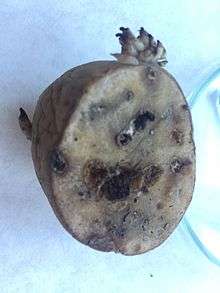Tecia solanivora
Tecia solanivora, the Central American potato tuberworm, Guatemalan tuber moth, or Guatemalan potato moth, is a moth in the family Gelechiidae. It was described by Povolný in 1973. It is found from Guatemala, through Central America (Costa Rica, El Salvador, Honduras, Nicaragua, Panama) to South America,[1] where it has been recorded from Colombia, Ecuador, Venezuela and Peru. It has also been introduced on the Canary Islands and mainland Spain.[2]
| Tecia solanivora | |
|---|---|
| Scientific classification | |
| Kingdom: | |
| Phylum: | |
| Class: | |
| Order: | |
| Family: | |
| Genus: | |
| Species: | T. solanivora |
| Binomial name | |
| Tecia solanivora (Povolný, 1973) | |
| Synonyms | |
| |
The wingspan is 9–10 mm for males and 13 mm for females. Adult females are bright brown, with three marks and bright brown longitudinal lines on the forewings. Males are dark brown with two marks on the forewings and scarcely visible longitudinal lines.
The larvae feed on Solanum tuberosum (potato). They enter tubers and feed on them, building galleries which may completely destroy the tuber. Full-grown larvae leave the tubers to pupate.[3]
The Guatemalan tuber moth, in sufficiently large infestations, can lead to a complete yield loss. Although there is natural variation in the tolerance of potato varieties to feeding by Guatemalan tuber moths, higher tolerance is associated with decreased yield in the absence of infestation.[4] In some potato varieties, notably Pastusa Suprema, infestation of a small number of tubers on each plant can cause uninfested tubers on the infested plants to become larger, leading to increased yield (up to around 20%).[5][6][7] Changes in photosynthesis and increased starch accumulation in uninfested tubers begin within days of Guatemalan tuber moth infestation.[8] Tuber infestation by Guatemalan tuber moths also increases above-ground potato resistance to feeding by two other lepidopteran pests, beet armyworms (Spodoptera exigua) and fall armyworms (Spodoptera frugiperda).[9]

References
- funet.fi
- EPPO (30 May 2018). "Tecia solanivora(TECASO)". EPPO. Retrieved 19 June 2018.
- Data sheets on quarantine pests - Tecia solanivora Archived 2015-06-04 at the Wayback Machine
- Garrido, Etzel; Díaz, Maria Fernanda; Bernal, Hugo; Ñustez, Carlos Eduardo; Thaler, Jennifer; Jander, Georg; Poveda, Katja (2017). Schädler, Martin (ed.). "Costs and Tradeoffs of Resistance and Tolerance to Belowground Herbivory in Potato". PLOS ONE. 12 (1): e0169083. doi:10.1371/journal.pone.0169083. ISSN 1932-6203. PMC 5240997. PMID 28095490.
- "Mottenspucke verbessert Ernte" [Moth spit improves yield]. Eigenarten der Natur (in German). N-TV. June 3, 2010.
- Poveda, Katja; Jiménez, María Isabel Gómez; Kessler, André (2010). "The enemy as ally: herbivore-induced increase in crop yield". Ecological Applications. 20 (7): 1787–1793. doi:10.1890/09-1726.1. ISSN 1051-0761. PMID 21049868.
- Poveda, Katja; Díaz, María F.; Ramirez, Augusto (2018). "Can overcompensation increase crop production?". Ecology. 99 (2): 270–280. doi:10.1002/ecy.2088.
- Kumar, Pavan; Garrido, Etzel; Zhao, Kun; Zheng, Yi; Alseekh, Saleh; Vargas-Ortiz, Erandi; Fernie, Alisdair R.; Fei, Zhangjun; Poveda, Katja (2018). "Tecia solanivora infestation increases tuber starch accumulation in Pastusa Suprema potatoes: Potato responses to tuber moths". Journal of Integrative Plant Biology. 60 (11): 1083–1096. doi:10.1111/jipb.12675.
- Kumar, Pavan; Ortiz, Erandi Vargas; Garrido, Etzel; Poveda, Katja; Jander, Georg (2016). "Potato tuber herbivory increases resistance to aboveground lepidopteran herbivores". Oecologia. 182 (1): 177–187. doi:10.1007/s00442-016-3633-2. ISSN 0029-8549.